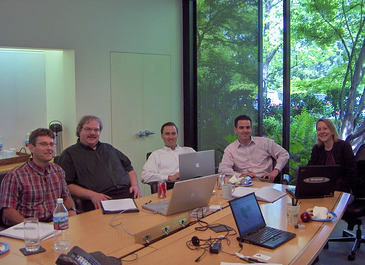|
Meetings can be bad enough when everyone is in the same room, but when participants are scattered across the globe, they can be downright unbearable. From listening to people eat, to hearing people type, and to having to repeat information for those who checked-out part way through, we're all in need of ideas to improve distributed meetings.
1. Decrease the scheduling hassle. If your participants are scattered across time zones, it can be difficult to keep track of who's up and who's asleep. Timeanddate.com has a nifty color-coded tool that shows at a glance who's working and who's off. Red is for sleeping, green is for working, and yellow is for likely to be out of office. 2. Rotate the time. Often the person running the meeting sets the meeting time based on her schedule. This is great for the leader, but if you're based in Boston, for example, then your Beijing team is never going to be at it's best on the calls, and if the calls are frequent, they will also start getting grumpy. Switch the times up so everyone has an chance to be on the call during normal working hours. 3. Consider hiring interpreters. If your distributed team speaks English, but in a somewhat limited fashion, or you're holding an international meeting with a client, you might get better results if you involve an interpreter. Lots of companies waste time through simple misunderstandings. At one company I worked for, we thought out British team was on-board with our plans when they said they were "fine" with them. Turns out, "fine" meant not at all happy; we needed to strive for having the plans be "brilliant", and that conversation was all in English! Interpreters for conference calls don't have to be on site. They can call in from a separate location, which can reduce cost, since travel time and inconvenience won't be an issue. 4. Speak Slowly When people can't see you and cue off of your body language and your face while you speak, they have to rely solely on your voice. Also, they may be trying to participate using their second language. You need to make sure everyone on the call really slows down when they talk. They need to pause more frequently, and they need to ask more check-in questions as they go. This brings us to the next point... 5. Summarize More You can't see who has fallen asleep or has started to play a game on his lap top, so you need to ask dial-in attendees to summarize what they think they've heard and outline what their action steps are. Otherwise you're likely to get a lot of comments like "yes, we're good with that," when what they really mean is "hmmm...I have no idea what was just said." 6. Excellent Minutes Finally, you'll want to designate someone to be in charge of taking detailed, clear notes of the meeting and distributing them quickly afterwards. This will help clear up any lingering ambiguity. If you use a localization agency, it can be useful for you to have the notes translated, again to make sure that the meeting outcomes and action steps are as clear as possible.
0 Comments
Leave a Reply. |
Author
Archives
March 2024
Categories
All
|
Photos from : : Ys [waiz] : :, bjahind, fabola, MattysFlicks, @sage_solar, LoS, Traducción e Interpretación, Kyle Taylor, Dream It. Do It., _gee_, keepitsurreal, One Way Stock, Airviewsphotos, GotCredit, efile989, Benoit cars, ** RCB **, stephiesal853, Francisco Anzola, Highways England, ITU Pictures, VIPevent, leoplus, Karsten Bitter, Jolante, jobstop11, Nguyen Vu Hung (vuhung), jurvetson, mikefats, YooSan, sandrafdzh, roland, mikecogh, y entonces, Donald Lee Pardue, Gatorgoon, daniel0685, BÜNDNIS 90/DIE GRÜNEN, rick, {Guerrilla Futures | Jason Tester}, mikecogh, markyharky, amslerPIX, jo.sau, IAEA Imagebank, lisa-skorpion, Toronto Public Library Special Collections, Wootang01


 RSS Feed
RSS Feed
